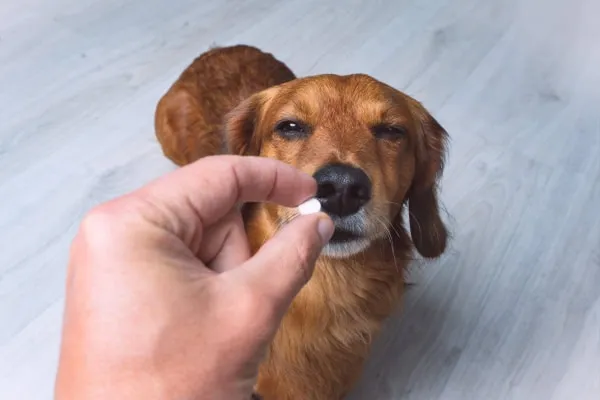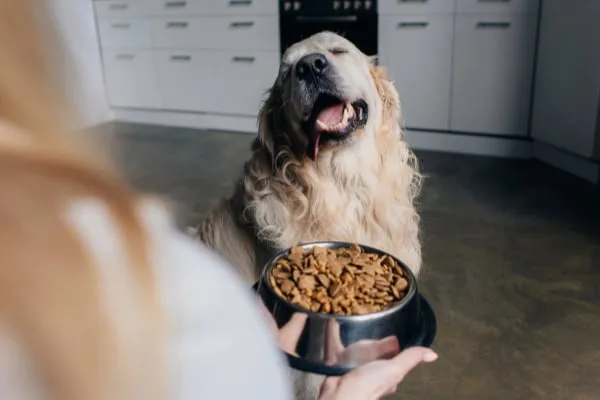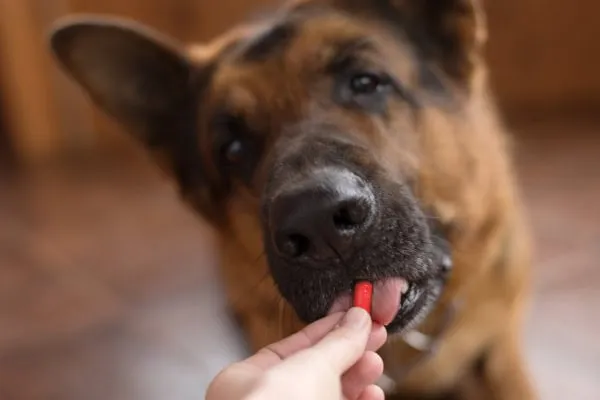Giving your canine companion medication can often feel like a covert operation. Many dog owners face the challenge of administering pills, only for their clever pups to meticulously work around the disguise. As a veterinarian with over 25 years of experience, I’ve witnessed countless such struggles. The good news? It’s entirely possible to make medication time stress-free, especially when armed with knowledge of the best, and often healthiest, foods for concealing pills. The goal is to ensure your dog consumes their medication without realizing it, simplifying the process for both of you.
Success hinges on selecting the right camouflage. We’re not just seeking any food, but specifically Healthy Pill Pockets For Dogs that effectively hide medication while remaining safe and palatable. This minimizes the risk of your dog spitting out the pill and ensures full dosage. From specially designed treats to common pantry staples, numerous options can transform a dreaded task into a seamless part of your dog’s routine. However, remember that every dog is unique; what works for one may not work for another. Always consider your dog’s specific dietary needs, medical conditions, and preferences.
Before exploring our top recommendations for creating effective and heartworm meds for dogs to conceal pills, it is vital to consult your veterinarian. They can offer personalized advice, ensuring your chosen food won’t negatively impact your dog’s health or interfere with current medications. Not all foods suit every dog, particularly those with pre-existing conditions like pancreatitis or allergies. Your vet is your best resource for tailored guidance, empowering you with veterinarian-approved options to transform pill time into a positive experience.
The Best Healthy Pill Pockets for Dogs: Vet-Recommended Options
Successfully administering medication to your dog begins with selecting the right “pill pocket.” The ideal choice not only conceals the medication but also aligns with your dog’s health needs. Here are veterinarian-approved options, from commercial solutions to wholesome human foods.
1. Commercial Pill Pockets
Many dog owners ask if there are treats specifically designed for hiding pills—yes! Products like Greenies Pill Pockets® are prime examples of healthy pill pockets for dogs engineered to simplify medication. These soft, moldable treats feature a pre-formed pouch, making pill insertion incredibly easy. Their playdough-like consistency allows you to effortlessly pinch the opening closed, completely encasing the pill. This secure enclosure significantly reduces the likelihood of detection or rejection.
Commercial pill pockets are a top choice because they are formulated for dogs, ensuring safety and palatability. They come in various flavors (chicken, peanut butter, cheese), catering to diverse preferences, and are available in sizes for both tablets and capsules, sometimes accommodating multiple small pills. Their convenience and effectiveness make them a favored solution for pet parents.
 A senior Dachshund dog looking suspiciously at a pill, implying the need for better hiding
A senior Dachshund dog looking suspiciously at a pill, implying the need for better hiding
2. Peanut Butter: A Classic Healthy Pill Pocket Option
For human food enthusiasts, peanut butter is a highly popular choice for creating healthy pill pockets for dogs. Its thick, gooey consistency makes it exceptionally difficult for your dog to separate the pill from the tasty treat. The strong, appealing flavor effectively masks the bitter taste of many medications. Most dogs adore peanut butter, making it a highly effective disguise.
However, caution is paramount. Always scrutinize the label for xylitol (birch sugar), a common sugar substitute profoundly toxic to dogs. Avoid all sugar-free or low-sugar peanut butter varieties. Furthermore, peanut butter is typically high in fat, unsuitable for dogs prone to pancreatitis. Its sodium content can also concern dogs on low-sodium diets due to heart or kidney disease. When in doubt, consult your veterinarian to ensure safety.
 A spoon with creamy peanut butter, ready to conceal a dog's medication
A spoon with creamy peanut butter, ready to conceal a dog's medication
3. Marshmallows: A Surprising, Low-Fat Healthy Pill Pocket
Marshmallows, while a human treat, can be a surprisingly effective and relatively low-fat option for creating healthy pill pockets for dogs. Their sticky, pliable texture is excellent for completely encasing and hiding medication. A key advantage is their low-fat content, making them a safer alternative for dogs at risk of pancreatitis compared to fattier options. Mini marshmallows are often perfectly sized, but larger ones can be molded for bigger pills.
Despite benefits, marshmallows require consideration. They are high in sugar, unsuitable for diabetic dogs. Like peanut butter, avoid sugar-free marshmallows due to potential xylitol. Opt for regular, plain marshmallows and use sparingly. Discuss this option with your vet if your dog has underlying health issues.
If you are looking for more affordable options for your pet’s healthcare, check out our guide on discount flea and tick medicine for dogs.
 Soft white marshmallows laid out on a surface, ideal for hiding pills
Soft white marshmallows laid out on a surface, ideal for hiding pills
4. Lean Meats: Turkey or Chicken as Healthy Pill Pockets
Plain, cooked lean meats like turkey or chicken breast serve as excellent healthy pill pockets for dogs. A small cube of cooked chicken or turkey can be incredibly enticing. Their strong natural scent and flavor often distract dogs from hidden medication, leading to quick ingestion.
The primary benefit of plain cooked turkey or chicken is their lean nature. Unlike richer meats (e.g., ham, roast beef), they are less likely to trigger pancreatitis. However, crucial precautions apply. Deli meats are high in sodium and preservatives, making them unsuitable, especially for long-term use or for dogs with heart or kidney disease. Even lean, cooked turkey and chicken should be avoided if your dog has a history of pancreatitis. Raw meats are strictly prohibited due to food-borne illness risks.
 Shredded plain cooked chicken, a lean and appealing option for hiding pills
Shredded plain cooked chicken, a lean and appealing option for hiding pills
5. Hot Dogs: A Tempting (But Cautious) Pill Pocket
Hot dogs are another frequently used meat option for creating healthy pill pockets for dogs, often due to their irresistible smell and taste. Their soft, moldable texture easily embeds a pill. Most dogs eagerly snatch a piece of hot dog, often swallowing it before realizing a pill is inside.
Despite their appeal, hot dogs require significant caution. They can pose a choking hazard if swallowed too quickly or improperly cut. Crucially, slice hot dogs into discs, then quarter them, to create small, manageable pieces. Hot dogs are not recommended for continuous use due to high sodium and preservative content, detrimental for dogs with chronic conditions like heart or kidney disease. They are also a poor choice for pancreatitis-prone dogs. Use hot dogs sparingly and with utmost care.
6. Liverwurst: A Potent and Moldable Pill Pocket
Liverwurst (braunschweiger) is a highly effective, albeit richer, option for hiding dog pills. Its strong aroma and flavor appeal to most dogs, making it an excellent masking agent. Its soft, spreadable consistency allows easy molding around a pill, creating a secure disguise.
A common concern with liverwurst is onion content. While onions are toxic, the small quantity in a tiny portion used for pilling is generally low risk according to veterinary toxicologists. For maximum safety, seek an onion-free variety. Given its richness, liverwurst may be risky for dogs prone to pancreatitis; consider alternatives for these sensitive pups. Always prioritize your dog’s specific health needs.
Beyond administering medication, protecting your dog from parasites is equally important. Learn more about effective medicine for ticks and fleas in dogs here.
7. Plain Yogurt: A Softer Healthy Pill Pocket Option
Plain yogurt or plain Greek yogurt offers a versatile and potentially beneficial option for creating healthy pill pockets for dogs. Its creamy texture is useful for mixing with liquid medications, if compatible. Yogurt also contains probiotics, contributing to gut health, and is a safer, lower-fat option for pancreatitis-susceptible dogs.
Always choose plain, unflavored varieties. Flavored yogurts contain added sugars, and sugar-free yogurts can contain xylitol, which is toxic. Yogurt is not as sticky as peanut butter, so clever dogs might lick it slowly and discover the pill. This method works best for dogs who gulp quickly. Importantly, avoid giving antibiotic pills or liquids with dairy, as calcium can interfere with antibiotic efficacy. Some dogs are lactose sensitive and may experience mild GI upset.
 A cup of plain yogurt with a spoon, ready to be used as a pill hider for a dog
A cup of plain yogurt with a spoon, ready to be used as a pill hider for a dog
8. Bananas: A Naturally Sweet Pill Pocket
Bananas offer a naturally sweet and flavorful option for hiding dog medications. Their strong scent can mask a pill, making them a tempting treat. Bananas are generally safe and healthy in moderation.
However, like yogurt, some clever dogs might pick out the pill rather than swallowing it whole. This method is often most successful with eager eaters. While a good source of vitamins, bananas are high in sugar, so offer small amounts, especially for diabetic or overweight dogs.
For dogs suffering from skin issues, finding the right care is essential. Explore options for best anti itch allergy medicine for dogs to help soothe their discomfort.
9. Bread: A Simple, Yet Cautionary Pill Pocket
Small pieces of plain bread can be a simple, accessible way to create a temporary pill pocket. Its soft, pliable nature allows easy concealment, and a tiny bit of xylitol-free peanut butter can enhance appeal.
However, bread has significant drawbacks. Prolonged use can contribute to weight gain, making it unsuitable for diabetic or overweight dogs. More critically, never offer bread dough (dangerous when consumed), or bread containing raisins or chocolate chips (both highly toxic). Stick to plain white or brown bread or buns, used occasionally and with supervision. Due to nutritional limitations and potential risks, bread is generally not a top recommendation for healthy pill pockets for dogs.
10. Canned Dog Food: A Reliable and Healthy Pill Pocket
For dogs accustomed to dry kibble, a small amount of canned dog food can feel like a special indulgence, making it an excellent and reliable pill-hiding option. Canned dog food is specifically formulated for canines, generally safe and appealing. If your dog is on a prescription diet, using the canned version is ideal, maintaining their dietary requirements without introducing allergens.
Canned food’s soft, uniform texture allows easy mixing or embedding of pills, and its strong aroma often masks the medication. This method is highly recommended, especially for dogs with specific dietary needs, offering a safe and effective way to administer medication without compromising their health plan. It provides a convenient and nutritionally sound approach to creating healthy pill pockets for dogs.
 A dog eagerly waiting for his food, with a pill expertly hidden within his kibble bowl
A dog eagerly waiting for his food, with a pill expertly hidden within his kibble bowl
11. Your Dog’s Normal Diet: The Simplest Pill Pocket
For some dogs, their regular kibble or raw diet is so motivating that a pill can simply be hidden within a small portion of their meal. This is arguably the easiest and most straightforward “pill pocket” method, requiring no additional ingredients. It works best for truly food-motivated and un-picky eaters.
However, this method has limitations. Many dogs will meticulously pick out the pill, or learn that their meal consistently contains medication, leading to refusal. Reserve this strategy for un-picky eaters or short-term medication needs.
What About Cheese, Cream Cheese, or Ice Cream as Healthy Pill Pockets?
While tempting for palatability and ease of concealment, rich dairy products like cheese, cream cheese, or ice cream are generally not recommended as healthy pill pockets for dogs. My personal veterinary opinion is to avoid these due to high fat content, which can trigger pancreatitis—a serious and potentially life-threatening condition.
Furthermore, many dogs are lactose intolerant and can experience gastrointestinal upset from dairy. Dairy products can also interfere with certain antibiotic efficacy, as their calcium can bind with medication, reducing absorption. Despite their appeal, safer alternatives for hiding pills pose fewer health risks.
Essential Precautions for Giving Pills in Healthy Pill Pockets
Successful medication administration involves adhering to critical precautions to ensure your dog’s safety and the medication’s effectiveness. Before grabbing any food, keep these veterinarian-approved tips in mind.
1. Always Consult Your Veterinarian First
Before choosing any food to hide pills, a conversation with your veterinarian is paramount. Certain foods are contraindicated for dogs with specific health conditions. High-fat foods are strictly avoided for pancreatitis-prone dogs. Those with kidney or heart disease often require specific low-sodium diets, making many human foods unsafe. If your dog is on a hypoallergenic diet, new foods could trigger allergies. Your vet identifies safe options that won’t interfere. Remember, calcium-rich foods should also be avoided with antibiotics.
2. Verify Medication Instructions for Food Compatibility
Always read the label or instructions for your dog’s medication. Some must be given on an empty stomach, or at a specific time relative to meals. In such cases, a food-based pill pocket is not an option. Ignoring instructions can render medication ineffective or harmful.
3. Avoid Crushing Tablets or Opening Capsules Without Vet Approval
Never crush tablets or open capsules to mix into food unless explicitly approved by your veterinarian. Altering medication form can change its efficacy, absorption rate, or create health risks. Some medications are extended-release or coated; crushing them destroys these properties. Seek your vet’s guidance before modifying any medication.
 A German Shepherd dog gently taking a pill from its owner's hand
A German Shepherd dog gently taking a pill from its owner's hand
4. Explore Other Medication Administration Methods
Even with the best healthy pill pockets for dogs, some clever canines may outsmart you or develop aversion. If struggling, discuss other options with your veterinarian. They might suggest compounding medication into a flavored liquid, a chewable treat, or a transdermal cream. Alternative treatment approaches may also be available. Your vet is a valuable partner in finding a solution.
5. Always Double-Check Medication Labels and Dosing
Review the medication label each time you administer it, even if your dog has been on it for a while. Your veterinarian might adjust dosage or frequency. Administering the wrong amount or at an incorrect frequency has serious negative consequences, so a quick double-check ensures accuracy and safety.
6. Keep Food Pieces Small for Swallowing Whole
To maximize pill concealment and ensure it’s swallowed whole, the food piece used as a pill pocket must be small enough for your dog to gulp down in one go. If your dog chews the food, they are more likely to discover the pill, leading to refusal. Smaller pieces reduce chewing time and increase rapid, complete ingestion.
Beyond daily medications, being prepared for emergencies like tick exposure is vital. Familiarize yourself with best tick removal medicine for dogs to protect your dog.
You Can Do It: Mastering Healthy Pill Pockets for Dogs
Administering medication to your dog can initially seem daunting. However, with the right approach and patience, it is absolutely achievable. By exploring various healthy pill pockets for dogs—from commercial products to carefully selected human foods—you are well-equipped to find a method that works seamlessly for your canine companion. It might take some trial and error, but the consistency and routine established will make medication time straightforward and positive.
Remember, the goal is not just to get the pill down, but to do so safely, effectively, and with minimal stress. Prioritize your dog’s health by avoiding adverse foods and always consulting your veterinarian for personalized advice. If, despite your efforts, you struggle with medication, do not hesitate to reach out to your vet. They are there to support you and are invested in your dog’s successful treatment. Together, you can find a solution that ensures your furry friend receives the care they need to thrive.
